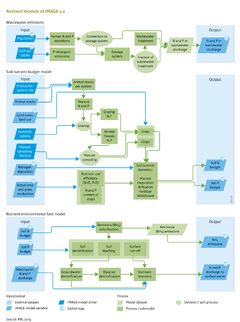Nutrients: Difference between revisions
Jump to navigation
Jump to search
No edit summary |
No edit summary |
||
| Line 3: | Line 3: | ||
|FrameworkElementType=state component | |FrameworkElementType=state component | ||
|Status=On hold | |Status=On hold | ||
|KeyReference=Bouwman et al., 2013; Bouwman et al., 2009; Van Drecht et al., 2009; | |KeyReference=Bouwman et al., 2013; Bouwman et al., 2009; Van Drecht et al., 2009; | ||
|Reference=Bouwman et al., 2011; Galloway et al., 2004; Zhang et al., 2010; Diaz and Rosenberg, 2008; UNEP, 2002; Rabalais, 2002; | |Reference=Bouwman et al., 2011; Galloway et al., 2004; Zhang et al., 2010; Diaz and Rosenberg, 2008; UNEP, 2002; Rabalais, 2002; | ||
|InputVar=Population per Region; Urbanisation; GDP per capita; Land cover; Crop production; Fertilizer use efficiency; Animal stock; Livestock ration; Manure spreading fraction; Nitrogen deposition; | |InputVar=Population per Region; Urbanisation; GDP per capita; Land cover; Crop production; Fertilizer use efficiency; Animal stock; Livestock ration; Manure spreading fraction; Nitrogen deposition; | ||
| Line 10: | Line 10: | ||
This has resulted in numerous negative impacts on human health and the environment, such as groundwater pollution, loss of habitat and biodiversity, an increases in the frequency and severity of harmful algal blooms, eutrophication, hypoxia and fish kills ([[Diaz and Rosenberg, 2008]]; [[Zhang et al., 2010]]). Such harmful effects of eutrophication have been spreading rapidly around the world, with large-scale implications for biodiversity, water quality, fisheries and recreation, in both industrialised and developing regions ([[UNEP, 2002]]). In freshwater and coastal marine ecosystems it is not only the input of nutrients but also the disturbance of the stoichiometric balance of N, P and silica (Si) ([[Rabalais, 2002]]) that affect both the total plant production and the species that dominate the ecosystems. | This has resulted in numerous negative impacts on human health and the environment, such as groundwater pollution, loss of habitat and biodiversity, an increases in the frequency and severity of harmful algal blooms, eutrophication, hypoxia and fish kills ([[Diaz and Rosenberg, 2008]]; [[Zhang et al., 2010]]). Such harmful effects of eutrophication have been spreading rapidly around the world, with large-scale implications for biodiversity, water quality, fisheries and recreation, in both industrialised and developing regions ([[UNEP, 2002]]). In freshwater and coastal marine ecosystems it is not only the input of nutrients but also the disturbance of the stoichiometric balance of N, P and silica (Si) ([[Rabalais, 2002]]) that affect both the total plant production and the species that dominate the ecosystems. | ||
To assess eutrophication as a consequence of changing population, economy and technological development, IMAGE 3.0 includes a nutrient model with three submodels: | To assess eutrophication as a consequence of changing population, economy and technological development, IMAGE 3.0 includes a nutrient model with three submodels: | ||
# The Wastewater model (See figure on the right I | # The Wastewater model (See figure on the right I), which generates nutrient flows in wastewater discharges; | ||
# The Soil nutrient budget model (See figure on the right II), describing all input and output of N and P in soil compartments; | # The Soil nutrient budget model (See figure on the right II), describing all input and output of N and P in soil compartments; | ||
# The Nutrient environmental fate model (See figure on the right III), which describes the fate of soil nutrient surpluses and wastewater nutrients in the aquatic environment. | # The Nutrient environmental fate model (See figure on the right III), which describes the fate of soil nutrient surpluses and wastewater nutrients in the aquatic environment. | ||
}} | }} | ||
Revision as of 12:39, 16 December 2013
| Component is implemented in: |
| Components: |
| Related IMAGE components |
| Projects/Applications |
| Key publications |
| References |
Key policy issues
- How will the increasing use of fertilisers affect terrestrial and marine ecosystems, with possible consequences for human health?
- To what extent can the negative impacts be reduced by more efficient nutrient management and wastewater treatment, while retaining the positive effects on food production and land productivity?
